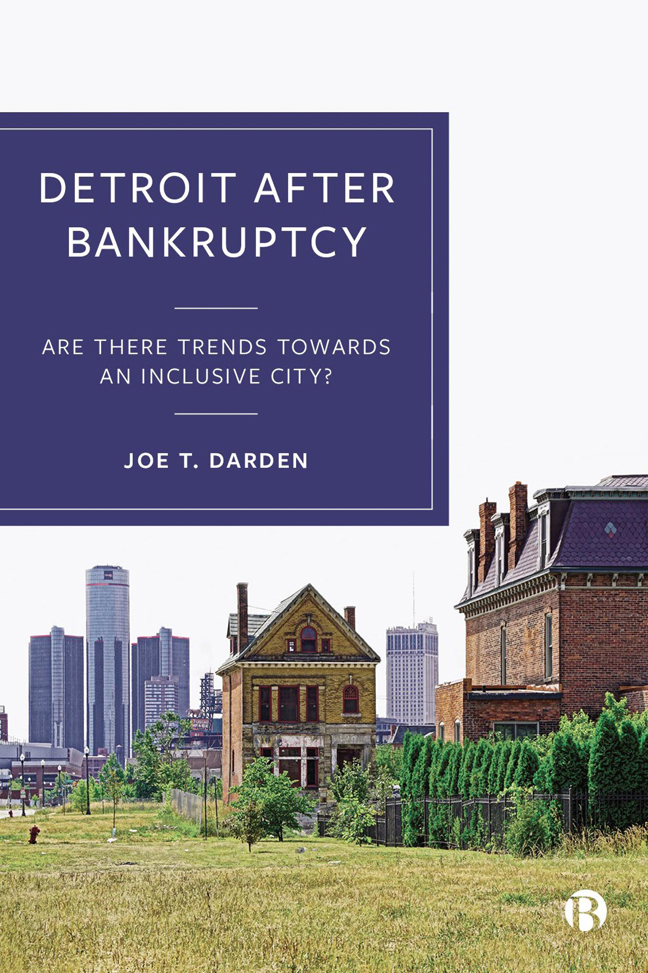Book contents
- Frontmatter
- Dedication
- Contents
- List of Figures and Tables
- Acknowledgments
- Preface
- 1 Antecedents to Bankruptcy
- 2 Detroit Bankruptcy: The Characteristics of the Decision Makers and the Differential Benefits Afterwards
- 3 The Postbankruptcy Social and Spatial Structure of Metropolitan Detroit: Anatomy of Class and Racial Residential Segregation
- 4 Gentrification: A New Method to Measure Where the Process Is Occurring by Neighborhood
- 5 The Uneven Distribution of Economic Redevelopment: Which Neighborhoods Are Excluded?
- 6 Black and Hispanic Underrepresentation in Business Ownership in a Majority-Black City
- 7 Racial Inequality in Student Academic Achievement Levels: A Neighborhood Solution to the Problem
- 8 Unequal Exposure to Crime in the City of Detroit: A New Method to Measure Exposure by the Characteristics of Neighborhoods
- 9 Solving the Problem of Extreme Race and Class Inequality: Implementing the Spatial Mobility Alternative
- 10 Conclusions: The Status of the Residents of Detroit after Bankruptcy
- References
- Index
4 - Gentrification: A New Method to Measure Where the Process Is Occurring by Neighborhood
Published online by Cambridge University Press: 25 January 2024
- Frontmatter
- Dedication
- Contents
- List of Figures and Tables
- Acknowledgments
- Preface
- 1 Antecedents to Bankruptcy
- 2 Detroit Bankruptcy: The Characteristics of the Decision Makers and the Differential Benefits Afterwards
- 3 The Postbankruptcy Social and Spatial Structure of Metropolitan Detroit: Anatomy of Class and Racial Residential Segregation
- 4 Gentrification: A New Method to Measure Where the Process Is Occurring by Neighborhood
- 5 The Uneven Distribution of Economic Redevelopment: Which Neighborhoods Are Excluded?
- 6 Black and Hispanic Underrepresentation in Business Ownership in a Majority-Black City
- 7 Racial Inequality in Student Academic Achievement Levels: A Neighborhood Solution to the Problem
- 8 Unequal Exposure to Crime in the City of Detroit: A New Method to Measure Exposure by the Characteristics of Neighborhoods
- 9 Solving the Problem of Extreme Race and Class Inequality: Implementing the Spatial Mobility Alternative
- 10 Conclusions: The Status of the Residents of Detroit after Bankruptcy
- References
- Index
Summary
Introduction
Gentrification as a concept has not been easy to define. The concept was first introduced by sociologist Ruth Glass in 1964 to describe “working class quarters [that] have been invaded by the middle class” (1964: xvii). Glass first defined gentrification as a process of change in the social structure of deprived working-class neighborhoods due to the moving in of middle-and upperclass citizens, and the subsequent requalification of the housing stock and displacement of incumbent residents. I notice her use of the same words used by E.W. Burgess (1925) to describe movement of the low-income population into middle-class neighborhoods in the City of Chicago. The concept is also difficult in that there has not been agreement among researchers about its causes and consequences (Vigdor et al, 2002; Freeman, 2005; Lees et al, 2010; Brown-Saracino, 2013).
The objectives
This chapter has several objectives. The first is to determine whether gentrification occurred in Detroit as defined by a new method, the Darden-Kamel Composite Socioeconomic Index (CSI). This defines gentrification as a process that results in a change in the entire neighborhood from very low and low socioeconomic characteristics to at least middle, high, or very high socioeconomic characteristics. A second objective is to determine the location of the neighborhoods where gentrification occurred using geographic information system (GIS) techniques to map the location. The final three objectives are connected as follows: to determine whether gentrification resulted in an increase in the white population; to determine whether the white population and the Black population are less residentially segregated in the gentrified census tracts than they were before the tracts became gentrified; and to determine whether the City of Detroit's Private–Public model for economic development leading to gentrification has provided useful assistance to neighborhood residents in their efforts to negotiate with developers in their neighborhoods through the process of “community benefits agreements.”
Past studies of gentrification
Over the years, other researchers have agreed with Glass’ (1964) definition of the process of gentrification. For example, Clark (2005) wrote that gentrification is a process involving a change in the population of land users such that the new users are of a higher socioeconomic status than the previous users, together with an associated change in the built environment through reinvestment in fixed capital.
- Type
- Chapter
- Information
- Detroit after BankruptcyAre There Trends towards an Inclusive City?, pp. 60 - 78Publisher: Bristol University PressPrint publication year: 2023



